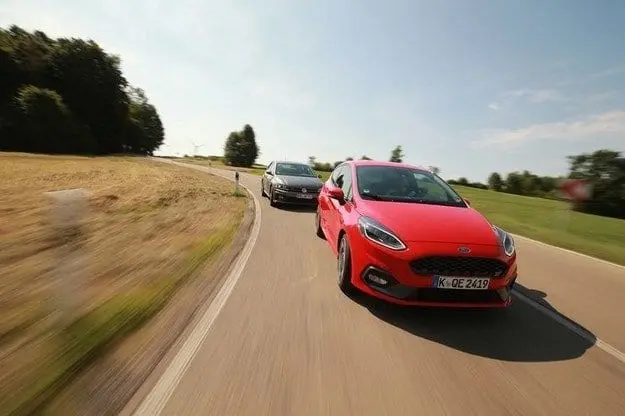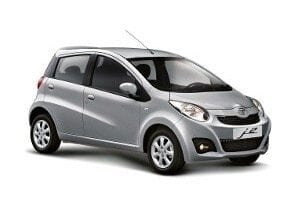
Test drive Ford Fiesta ST and VW Polo GTI: little athletes of 200 hp each.

Which of the two power hungry toddlers brings more joy on the road?
Roles in small sports models are clearly distributed: the VW Polo GTI is a powerful dwarf, and the Ford Fiesta ST is a rude bully. Although its turbo engine is one cylinder smaller, its output is also 200 hp. It is still unknown who will pursue whom, overtake or overtake.
For a change, this time we first put aside the topic of interior space and functionality. Here, the regular Polo has proven time and time again to be hard to beat. No, today we will talk first of all about driving pleasure - after all, otherwise reasonable rivals Ford Fiesta and VW Polo are tested in sports versions of ST and GTI, respectively. So let's start right away with the part where we rate the driving experience.
According to the registration cards, both cars have a power of exactly 200 hp. However, these foals come from different stables. VW has a two-liter four-cylinder turbocharger with combined in-cylinder and intake manifold injection that delivers full throttle design at 4000 rpm. Even at 1500 rpm, the torque is 320 Nm. In a direct comparison, the Ford model is 30 Newton meters, half a liter and a whole cylinder less. In addition, the Fiesta ST runs on only two cylinders in partial load mode. However, this is noticeable only by a slightly lower consumption in the test - 7,5 l / 100 km, which is 0,3 l less than the Polo.
Sensational ST, self-switching GTI
Thanks to the € 950 Performance Package, the ST not only has a differential lock on the front axle, but it also informs the driver of the ideal shift points from the dashboard and, when starting at full throttle, helps him control the start. With the start mode activated and the accelerator pedal fully depressed, the revs remain at about 3500, and when the left foot is removed from the clutch, the small Ford accelerates in 6,6 seconds to 100 km / h. Although the factory data is missing a little less than a tenth, the car demonstrates incredible, above all acoustic performance.
The three-cylinder engine only unleashes its full horsepower potential at 6000 rpm and gives an artificially boosted but by no means unnatural-sounding concert along the way. The gears of the six-speed manual transmission shift with incredible ease and short travel – a real pleasure to work with and accuracy that is almost second to none in this class.
This is especially true for the Polo because, unlike its predecessor, the GTI version is currently not equipped with a manual transmission, and this is actually a drawback when it comes to a small sports car. Maybe the dual-clutch transmission actually shifts gears faster, but some of the emotion is lost forever. Moreover, DSG is acting too hastily and shows weaknesses at launch. Drivers with sporty ambitions are annoyed by the fact that even in manual mode, the device prioritizes its own gear selection and automatically switches to a higher gear next to the speed limiter. True, the steering bar commands are executed immediately, but the shifting process itself takes a little longer than it should.
The Sport Polo can stand on the starting line even without a brake pedal launch control. Subjectively, the car breaks away from the starting blocks not so powerfully, purposefully, but not euphorically gaining momentum. However, measurements show that, despite the higher weight of one hundred kilograms, the model is on par with its competitor and even below the factory data. With intermediate acceleration, it catches up with the competitor to within tenths of a second and even reaches a top speed of 5 km / h (237 km / h).
Despite the more precise chassis tuning, the VW Polo GTI remains an obedient partner who is always ready to give in and does not impose anything on anyone. On secondary roads, the Ford Fiesta ST attacks every corner with eagerness, sometimes lifting the rear wheel from the inside, cornering with a torque vector and optional limited-slip differential, the Polo remains neutral for long periods. As it approaches the grip limit, it starts to understeer and forces the ESP to do its job. You can be sure of this, but it is somewhat disappointing for drivers with sporting ambitions.
Driving a Fiesta is an unforgettable experience
It's the same with the steering system. True, in the Polo it is straight, but not as sharp, creates an artificial feeling and therefore practically does not tell the driver about the condition of the road surface and grip on the front axle. And the fact that the Fiesta is at such an impressively high level is due, among other things, to the Michelin Supersport tires, which are otherwise fitted to cars with at least twice the horsepower.
So on the proving ground, the ST performs a double lane change almost seven km/h faster. And to make it clearer: the current Porsche 911 Carrera S is only XNUMX km / h faster. In this case, of course, the fact that, unlike the VW model, here, in Track mode, the ESP system can be completely disabled - but then the pilot must really know what he is doing. Ford's brakes are twofold - they work well and retain their effectiveness through repeated attempts, but they quickly heat up to high temperatures under heavy loads.
And in some other disciplines, the Fiesta scores fewer points than the VW representative. First, with nearly identical external dimensions, the Polo offers more space and a better cab experience. The standard rear doors make it more versatile, although the optional Beats music system takes up a fraction of the boot space. True, for an additional 800 euros, Ford also offers the ST in a four-door version, but some of the safety features of the regular Fiesta, such as pedestrian recognition, automatic distance monitoring and automatic parking assist, are not available for the top sports model.
Instead, Recaro seats with superb lateral support are standard here, although they can be a problem at BMIs above 25. And since we're already talking about comfort, the GTI's adaptive dampers provide perfectly harmonized driving comfort at the touch of a button. Even in sport mode, the car doesn't play too hard. While in the ST, on the contrary, the suspension travel is the minimum necessary and, above all, road bumps are not absorbed without exception. It is also less soundproof than the Polo.
Power comes at a price
In terms of power and equipment, the prices for two small cars can be called fair. In Germany, the Fiesta ST is listed in the price list up to 22 euros, which corresponds to 100 euros for each horsepower. The test car, however, adds € 111 to that amount for the Exklusiv leather package, which brought the ST in addition to leather sports seats, automatic air conditioning, audio system, large navigation system and 2800-inch wheels. More important, however, are the LED headlights (€ 18) and the Performance package, which is absolutely essential for sports drivers (€ 750).
Since the Polo is only available with four doors and a DSG gearbox, the model costs at least 23 euros, or about 950 euros for each horsepower. Even with the optional 120-inch wheels (€ 18) and Sport Select suspension, the model remains nearly € 450 below the current Fiesta price. However, in order to bring the VW model to the level of a nearly fully equipped Ford test car, a few more notes need to be made in the configurator. And since additional services are often more expensive in Wolfsburg than in Cologne, a comparable GTI actually gets a little more expensive.
The Polo ultimately wins in sum, but fans of the incredibly unfounded Fiesta ST will surely forgive that.
Text: Clemens Hirschfeld
Photo: Hans-Dieter Zeifert
Home " Articles " Blanks » Ford Fiesta ST and VW Polo GTI: 200 hp little athletes every.

